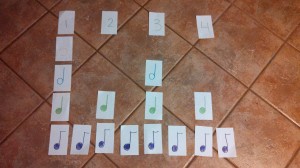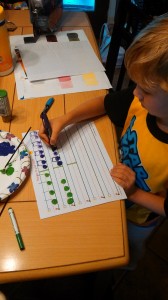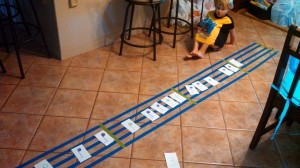My sister and I each grew up playing instruments – our choice, not our parents – because we had been exposed to music. I made the decision at 5 years old to play the violin after seeing an orchestra perform on TV. And what do you know? My new school that next year had a violin teacher! Watching that first chairperson on the TV screen sparked a passion in me that lasted throughout all of my school days.
Art, music, dance, and theater education are what mold our creativity, interests and passions, yet they are quickly the first things that are cut from the classroom due to budget cuts or lack of time for core subjects to be taught in a school day. The exposure to the arts that we once had in schools is quickly diminishing so it’s up to us Mommy Teachers to introduce these “extracurricular” activities at home.
If you have a talent or passion for the arts, share what you love with your child. If you don’t have a background in any of these areas, you have the world of knowledge at your fingertips! Google and YouTube can literally teach you the basics of anything you want to know!
Will my children share my same interests? Perhaps, perhaps not, but that exposure will help guide their interests and interests can quickly turn to passion and yes, I want my children to be passionate about something that they love.
My children have been exposed the few instruments that I dabble in and, to my dismay, this did not make my oldest child interested in music in the least bit – so don’t think you need to be a master musician to get your kids to like music. In fact, James (age 6) would always say, “Will you please stop playing the violin??? It’s too loud! It’s hurting my ears!” I honestly think he just doesn’t like anything making more noise than he does ;-), but, I digress…
What my son DOES like, is MATH! And music THEORY is basically math! Half notes, quarter notes, eighth notes… all math! And then there are (most commonly and for the sake of teaching young kids) 4 beats to each measure, that’s 1 whole note, or 2 half notes, or 4 quarter notes, or 8 eighth notes… or you have to figure out a combination of all of them that equals 4! WHOA! My math nerd was instantly hooked to MUSIC after our first lesson about clapping out the music!
 I started off by teaching the different notes, starting with the QUARTER NOTE.
I started off by teaching the different notes, starting with the QUARTER NOTE.
A quarter note is 1 count. So we count 1…2…3…4… and clap on each count… clap…clap…clap…clap.
The half note is 2 counts. 1…*…3…*… (clap on the numbers in bold, and hold the clap for the *. When counting, still say numbers 1…2…3…4…).
The whole note is 4 whole counts. 1…*…*…*… (only clap on the 1st count in the measure).
The eighth note is half of 1 count. For this note, we verbally and an “and” between our numbers when we count. 1 and 2 and 3 and 4 and. clap clap clap clap clap clap clap clap.
If you want to get real fancy, you can also introduce the sixteenth note which is a quarter of a quarter note. 1 ee and uh 2 ee and uh 3 ee and uh 4 ee and uh (there should be 16 claps in there). James: “Whoa that’s way too fast.” So we just stopped at the eighth note.
As I introduced the notes, we did a little art projects to put our notes into measures so he could see how 4 counts fit inside each measure.
 Now, I don’t just have blank music sheets lying around my house, so I used lined writing paper that the kids use in Pre-K and Kindergarten. 3 lines, 5 lines… that wasn’t my focus for this lesson.
Now, I don’t just have blank music sheets lying around my house, so I used lined writing paper that the kids use in Pre-K and Kindergarten. 3 lines, 5 lines… that wasn’t my focus for this lesson.
Materials:
- 4 small marshmallows
- markers
- paint (4 different colors)
- lined/handwriting paper
- 4 stirring straws
 1. Choose 4 colors of paint and decide which color will represent which note (the differences in color help the kids remember the notes better)
1. Choose 4 colors of paint and decide which color will represent which note (the differences in color help the kids remember the notes better)
2. Stick each marshmallow on the end of each stirring straw.
3. Draw “measure lines” on your paper. I put them down the middle so there was enough space for all of the eighth notes in one measure.
4. Start with the quarter note and dip the marshmallow into the paint. Put 4 quarter notes into one measure. I did the top line and had my child copy me on the line beneath. In the next measure, choose a different color for eighth notes. Dip a new marshmallow into the new color and put 8 eighth notes into the measure. Have your child copy you on the lines beneath.
5. Clap out your new song.
1…2…3…4…
1 and 2 and 3 and 4 and
1…2…3…4…
1 and 2 and 3 and 4 and
6. For the half and whole notes, choose 2 different colors of paint. This time, instead of dipping the whole marshmallow into the paint, just roll the edges of the marshmallow in the paint so you get the hallowed center for the note.
7. In a new measure, put 2 half notes into one measure, spaced evenly. In the next measure, put 1 whole note in the measure. Have your child copy you.
8. Clap out your new measures.
1…*…3…*…
1…*…*…*…
1…*…3…*…
1…*…*…*…
9. Then clap out your whole song:
1… 2… 3… 4…
1 and 2 and 3 and 4 and
1… 2… 3… 4…
1 and 2 and 3 and 4 and
1… *… 3… *…
1… *… *… *…
1… *… 3… *…
1… *… *… *…”
Here is a video of my 6 year old clapping the beat out on his own for the first time. He was so proud that I didn’t have to help him!
Yay! You and your child have just written your first song together! Feel free to add words to your music and more!
For our next activity, I created a giant musical staff (this time with 5 lines) on our floor using painters tape! We used our index cards with our notes from the picture above to figure out how we can fit 4 beats into each measure using a combination of all the notes we learned about! I used a different color tape for the measure lines because it was easier to see.
OTHER ACTIVITIES AND VARIATIONS OF ACTIVITIES:
- Clap out the notes in familiar simple songs such as “Twinkle, Twinkle Little Star” or “Mary had a Little Lamb.” Both of these songs uses quarter notes and half notes. See if you and your child can recreate these songs on your big musical staff!
- The song “BINGO” is a great way to practice clapping notes. “::clap:: I – N – G – O, ::clap:: I – N – G – O, ::clap:: I – N – G – O, and that’s how we spell Bingo.”
- Use other instruments instead of clapping: kazoo, pots and pans as drums, shakers, recorders, etc.
- What other parts of your body can you use to “sing” the music? Try stomping, jumping, squatting, conducting with your index finger, etc.
The possibilities are endless! Music is so much fun!


Love this post! My husband and I are both music lovers and have been teaching our almost 5 yr old how to sing by matching notes and even learning key changes. She’s a HUGE fan of listening to different styles of music on our kindle. Just last week we took her to see a local production of Annie and after just one exposure to it, she was singing the songs. These ideas will be a great way to expose her even more to music.